Ultrasound pregnancy
A pregnancy ultrasound is an imaging test that uses sound waves to create a picture of how a baby is developing in the womb (uterus). It is also used to check the female pelvic organs during pregnancy.
Ultrasound - Animation
Ultrasound is a useful procedure for monitoring the baby's development in the uterus. Ultrasound uses inaudible sound waves to produce a two-dimensional image of the baby while inside the mother's uterus. The sound waves bounce off solid structures in the body and are transformed into an image on a monitor screen. Solid structures, such as bones and muscles, reflect sound waves and appear as light gray or white. Soft or hollow areas, like the chambers of the heart, don't reflect sound waves and appear dark or black. An ultrasound can supply vital information about a mother's pregnancy and her baby's health. Even though there are no known risks for ultrasound at present, it is highly recommended that pregnant women consult their physician before undergoing this procedure.
How the Test is Performed
To have the procedure:
- You will lie on your back on an exam table.
- The person performing the test will spread a clear, water-based gel on your belly and pelvis area. A handheld probe will then be moved over the area. The gel helps the probe transmit sound waves.
- These waves bounce off the body structures, including the developing baby, to create a picture on the ultrasound machine.
In some cases, a pregnancy ultrasound may be done by placing the probe into the vagina. This is more likely in early pregnancy. Many women will have the length of their cervix measured by vaginal ultrasonography around 20 to 24 weeks of pregnancy.
Placing the probe into the vagina
Transvaginal ultrasound is a test used to look at a woman's uterus, ovaries, tubes, cervix, and pelvic area. Transvaginal means across or through the...

How to Prepare for the Test
You will need to have a full bladder to get the best ultrasound image. You may be asked to drink 2 to 3 glasses of liquid an hour before the test. DO NOT urinate before the procedure.
How the Test will Feel
There may be some discomfort from pressure on the full bladder. The conducting gel may feel slightly cold and wet. You will not feel the ultrasound waves.
Why the Test is Performed
An ultrasound may be done to determine if there is a problem with the pregnancy, how far along the pregnancy is, or to take measurements and screen for potential problems.
Talk to your health care provider to determine the most appropriate scanning schedule for you.
A pregnancy ultrasound may be done during the first 12 weeks of pregnancy to:
- Confirm a normal pregnancy
- Determine the baby's age
- Look for problems, such as ectopic pregnancies or the chances for a miscarriage
- Determine the baby's heart rate
- Look for multiple pregnancies (such as twins and triplets)
- Identify problems of the placenta, uterus, cervix, and ovaries
- Look for findings that might indicate an increased risk for Down syndrome
Down syndrome
The nuchal translucency test measures the nuchal fold thickness. This is an area of tissue at the back of an unborn baby's neck. Measuring this thi...
 ImageRead Article Now Book Mark Article
ImageRead Article Now Book Mark Article
A pregnancy ultrasound may also be done in the second and third trimesters to:
- Determine the baby's age, growth, position, and sometimes sex.
- Identify any problems with how the fetus is developing.
- Look for twins or triplets. Look at the placenta, amniotic fluid, and pelvis.
Some centers are now performing a pregnancy ultrasound called a nuchal translucency screening test around 9 to 13 weeks of pregnancy. This test is done to look for signs of Down syndrome or other problems in the developing baby. This test is often combined with blood tests to improve the accuracy of results.
Ultrasound may also be performed to guide certain diagnostic procedures in the first and second trimesters to test the placenta and amniotic fluid for certain genetic disorders.
How many ultrasounds you will need depends on whether a previous scan or blood test has detected problems that require follow-up testing.
Normal Results
The developing baby, placenta, amniotic fluid, and surrounding structures appear normal for the gestational age.
Note: Normal results may vary slightly. Talk to your provider about the meaning of your specific test results.
What Abnormal Results Mean
Abnormal ultrasound results may be due to some of the following conditions:
- Birth defects
- Ectopic pregnancy
Ectopic pregnancy
An ectopic pregnancy is a pregnancy that occurs outside the womb (uterus).
 ImageRead Article Now Book Mark Article
ImageRead Article Now Book Mark Article - Poor growth of a baby while in the mother's womb
- Multiple pregnancies
- Miscarriage
- Problems with the baby's position in the womb
- Problems with the placenta, including placenta previa and placental abruption
- Too little amniotic fluid
- Too much amniotic fluid (polyhydramnios)
Polyhydramnios
Polyhydramnios occurs when too much amniotic fluid builds up during pregnancy. It is also called amniotic fluid disorder, or hydramnios.
 ImageRead Article Now Book Mark Article
ImageRead Article Now Book Mark Article - Tumors of pregnancy, including gestational trophoblastic disease
- Other problems with the ovaries, uterus, and remaining pelvic structures
Risks
Current ultrasound techniques appear to be safe. Ultrasound does not involve radiation.
Reviewed By
LaQuita Martinez, MD, Department of Obstetrics and Gynecology, Emory Johns Creek Hospital, Alpharetta, GA. Also reviewed by David C. Dugdale, MD, Medical Director, Brenda Conaway, Editorial Director, and the A.D.A.M. Editorial team.
Dugoff L, Wapner RJ. Prenatal diagnosis of congenital disorders. In: Lockwood CJ, Copel JA, Dugoff L, et al, eds. Creasy and Resnik's Maternal-Fetal Medicine: Principles and Practice. 9th ed. Philadelphia, PA: Elsevier; 2023:chap 30.
Richards DS. Obstetric ultrasound: imaging, dating, growth, and anomaly. In: Landon MB, Galan HL, Jauniaux ERM, et al, eds. Gabbe's Obstetrics: Normal and Problem Pregnancies. 8th ed. Philadelphia, PA: Elsevier; 2021:chap 9.
Wolf RB. Fetal abdominal imaging. In: Lockwood CJ, Copel JA, Dugoff L, et al, eds. Creasy and Resnik's Maternal-Fetal Medicine: Principles and Practice. 9th ed. Philadelphia, PA: Elsevier; 2023:chap 24.


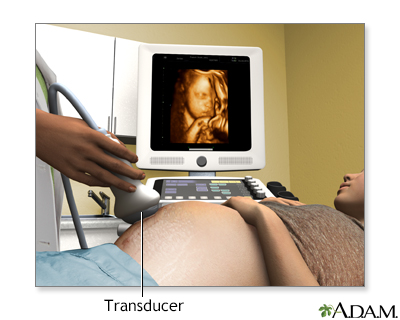

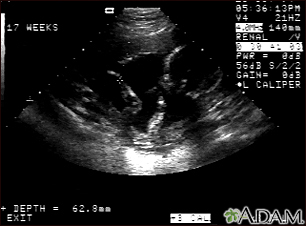













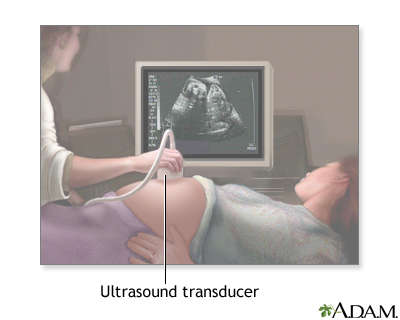

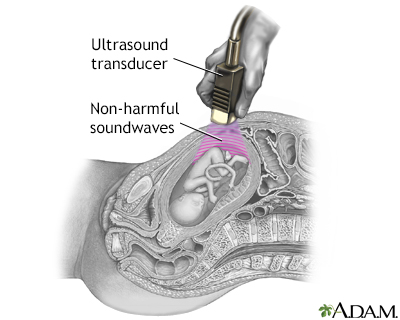
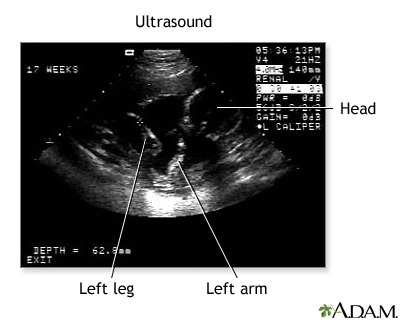
 All rights reserved.
All rights reserved.